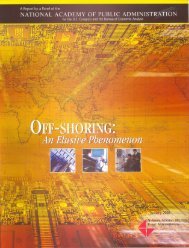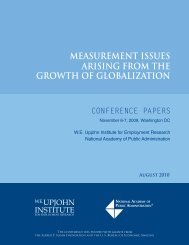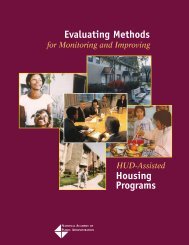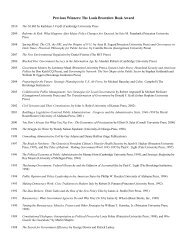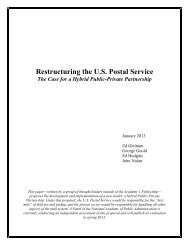High-Performance Partnerships - National Academy of Public ...
High-Performance Partnerships - National Academy of Public ...
High-Performance Partnerships - National Academy of Public ...
Create successful ePaper yourself
Turn your PDF publications into a flip-book with our unique Google optimized e-Paper software.
The PODER Project was a six-year<br />
initiative.The first three years<br />
focused on capacity building and the<br />
last three on implementation. The<br />
biggest challenge was to create a resident-driven<br />
advisory council that<br />
included all stakeholders. Initially,<br />
there was a great deal <strong>of</strong> conflict<br />
concerning which resident would<br />
control the council. This prolonged<br />
the time frame and created difficulties<br />
with existing and potential funders.<br />
During this period, the real<br />
leadership emerged to develop the<br />
capacity <strong>of</strong> the council.<br />
PODER/PATCH Project (Denver)<br />
4. Demonstrate that high-performance partnerships<br />
produce.<br />
Nothing generates support like success.<br />
Partners, stakeholders, and the community at<br />
large are more likely to back a winner than a<br />
partnership that has yet to produce. Widely<br />
communicating the partnership’s results is one<br />
way to encourage future support.<br />
STRUCTURING A PARTNERSHIP TO<br />
ACHIEVE RESULTS<br />
The Challenge<br />
An effective governance structure is critical for<br />
a high-performance partnership. There must<br />
be a mechanism to make decisions, allocate<br />
resources, and resolve conflicts. Yet it is difficult<br />
to implement one that accommodates<br />
both collective and individual needs. It is possible<br />
for a detached party to participate in the<br />
governance structure, but it generally has<br />
“stakeholders.” Stakeholders have an interest<br />
in the partnership’s enterprise and usually are<br />
an investor or beneficiary.<br />
Investors are individuals or organizations that<br />
contribute resources. Investors ultimately have<br />
the power to make decisions because they control<br />
the resources to act. They can make things<br />
happen or even veto the use <strong>of</strong> their resources<br />
if the partnership moves in a contrary direction.<br />
Investors are not necessarily involved in<br />
the partnership’s day-to-day activities, but provide<br />
the wherewithal for the activities to occur.<br />
Smart investors listen to and value the client’s<br />
input, but not necessarily include it in the<br />
decision-making structure. This does not<br />
mean that an investor-controlled partnership<br />
is ineffective in meeting customer expectations<br />
or service needs. At the same time, the<br />
approach runs the risk <strong>of</strong> appearing exclusionary<br />
or insensitive to some stakeholder interests.<br />
Beneficiaries are the subset <strong>of</strong> stakeholders that<br />
the partnership’s results affect. They can be<br />
direct customers or indirect beneficiaries, such<br />
as the community at large. They can influence<br />
the partnership’s decisions, but not independently<br />
control them. Certainly, a high-performance<br />
partnership must be customer-focused<br />
and routinely seek input and feedback.<br />
However, a customer service orientation is not<br />
synonymous with partnership governance.<br />
A partnership’s decision-making structure can<br />
be composed solely <strong>of</strong> investors or a combination<br />
<strong>of</strong> investors and other stakeholders. The<br />
former can facilitate action and results because<br />
key decision-makers and resource providers<br />
are in charge. But, an investor-only model<br />
must guard against disenfranchisement and<br />
lost support from other stakeholders.<br />
The federally-mandated Advisory Panel on<br />
Medicare Education is a governance structure that<br />
relies primarily on the stakeholder model. While<br />
CMS is the investor, the stakeholders make decisions<br />
and recommendations to guide the agency.<br />
The panel’s chair is from the stakeholder body.<br />
CMS is represented at the table but the panel<br />
works independently as a group, <strong>of</strong>fering critical<br />
guidance to the agency.<br />
Lovell Brigham, Centers for<br />
Medicare and Medicaid Services<br />
113 Powering the Future: <strong>High</strong>-<strong>Performance</strong> <strong>Partnerships</strong>




